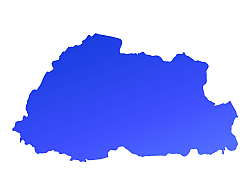
The landlocked country of Bhutan is wedged between China and India and nestled in the eastern Himalayas. The altitudes of the land, which can reach higher than 13,000 feet, can complicate travel. And with no modern transportation, it can take several days of walking to go from one village to the next. The weather varies greatly depending on the area of Bhutan, with extreme cold in the north and extreme heat in the south.
According to legend, Bhutan got its nickname when a Buddhist monk heard thunder and mistook it for the roar of a dragon after discovering the perfect piece of land on which to build a monastery. He named the monastery Druk, which translates to “thunder dragon.”
The Bhutanese culture is very unique compared to most other countries. The state measures its “development” by Gross National Happiness, striving to keep all citizens happy and at peace with one another. The people cling to ancestral traditions and guard their lifestyle from outsiders, making it one of the least developed countries in the world.
The Bhutanese people lead simple lives without the influence of modern technology. Yaks, horses and mules are used for transportation, and most people farm to earn a living.
They’re excellent marksmen with the bow and arrow and have a passion for their national sport of archery.
All Bhutanese citizens are required to follow the national dress code. Men wear a gho, which is a simple knee-length robe commonly made of wool and held in place by a woven piece of narrow cloth wrapped around the waist, creating a pocket. Knee-high socks are also worn. Women wear a kira, which is an ankle-length piece of cloth made of woven fabric that wraps around the body and is held together at the shoulders by brooches and secured at the waist with a wide belt. Some women also wear a short open jacket over their kira.
Religion heavily governs daily life for the people of Bhutan. Although Bhutan’s constitution allows for freedom of religion, most adhere to the tantric form of Mahayana Buddhism, the country’s spiritual heritage and official state religion.
Because religion is so intricately woven into people’s lives, evidence of this is seen everywhere. People hang colorful prayer flags and place them in front of monasteries in hopes that the wind will blow the prayers written on them to the gods. Prayer wheels are constantly spun with the belief that each revolution spreads spiritual blessings and good will. Monasteries are built on hilltops, and monks are placed in high-standing positions in government, giving them strong moral and spiritual influence over the people.
